Numerical Investigation of Disturbance Characteristics of Surrounding Rock in Ultra-Close Coal Seams Mining Based on Particle Flow
Abstract
1. Introduction
2. Engineering Conditions
3. Numerical Simulation Model Development and Testing
3.1. Research Approach
- Reduction in the number of strata in the vertical direction: In the simulation process, the strata directly related to the immediate roof and the coal seam play an important role. Therefore, only the portions directly related to these strata are selected. To eliminate the influence of other strata and ensure the accuracy of the model, the remaining overlying strata are replaced by a single flexible cluster with equivalent weight, based on the results of the in-situ stress test. For this study, only the layers from the 3upper coal seam to the second thick hard roof, and from the 3lower coal seam to the first thick hard floor, are retained. This results in a total of nine layers of rock, with a height of 94.66 m.
- Reduction in the lateral dimensions of the working face: A stress model for the main roof is developed, and the breakage length of the roof strata is determined through limit analysis. Based on these results, the width of the working face is reduced, which in turn minimizes the overall model length.
- Adjustment of particle size: Given that the study focuses on the macro-scale structural evolution and its impact, the size of the particles is increased accordingly.
3.2. Model Design
4. Simulation Results and Analysis
4.1. Formatting of Mathematical Components
4.2. Stress Analysis of the Surrounding Rock Induced by Mining Activities
4.2.1. Global Stress Distribution of the Surrounding Rock
4.2.2. Stress Evolution of the Siltstone Interlayer
4.3. Dynamic Evolution of Rock Layer Porosity
4.3.1. Global Porosity of the Surrounding Rock
4.3.2. Porosity of Siltstone Interlayer
5. Conclusions
- (1)
- The simplified particle flow model successfully replicates the theoretical fracturing lengths of the strata, with the initial stress levels observed in subsequent model monitoring being in good agreement with experimental measurements. This indicates that the model effectively simulates deep mining conditions, and the approach of simplifying the particle flow model is both practical and valid.
- (2)
- Mining of the 3upper coal seam primarily induces fracture propagation within the primary and secondary key strata, as well as compressive damage between rock blocks. The integrity of the siltstone interlayer layer remains largely unaffected by mining of the overlying coal seams. The mining of the 3lower coal seam leads to limited damage, primarily deepening the collapse of the overlying strata in the mined-out area and increasing the fragmentation of rock blocks, with minimal damage occurring to the surrounding rocks.
- (3)
- Mining of the 3upper coal seam results in significant stress redistribution within the surrounding rock, allowing clear differentiation between high-stress zones, low-stress zones, and areas exhibiting original rock stress levels. Mining of the 3lower coal seam generates a localized, multi-point high-stress distribution, and the stress patterns in the siltstone interlayer largely mirror the global stress behavior in the surrounding rock.
- (4)
- The porosity in fractured surrounding rock regions correlates with the compressive interactions between rock blocks. In areas with severe surrounding rock damage, an inverse relationship between stress and porosity is observed. Monitoring of the siltstone interlayer’s porosity further confirms that its integrity remains unaffected by the mining of the 3upper coal seam, with damage occurring only as a result of mining activities in the 3lower coal seam.
Author Contributions
Funding
Data Availability Statement
Conflicts of Interest
Abbreviations
| PFC2D | Particle Flow Code 2D |
References
- Yang, X.; Wen, G.; Dai, L.; Sun, H.; Li, X. Ground Subsidence and Surface Cracks Evolution from Shallow-Buried Close-Distance Multi-seam Mining: A Case Study in Bulianta Coal Mine. Rock Mech. Rock Eng. 2019, 52, 2835–2852. [Google Scholar] [CrossRef]
- Rajabi, M.; Ziegler, M.; Heidbach, O.; Mukherjee, S.; Esterle, J. Contribution of mine borehole data toward high-resolution stress mapping: An example from northern Bowen Basin, Australia. Int. J. Rock Mech. Min. Sci. 2024, 173, 105630. [Google Scholar] [CrossRef]
- Xu, H.; Zhai, C.; Xia, J.; Sun, Y.; Dong, X.; Lai, Y.; Xu, Y.; Xu, Z.; Cong, Y. Coal and rock interface imaging based on finite element method of through—Seam drilling acoustic wave far detection. Coal Field Geol. Explor. 2024, 52, 118–129. [Google Scholar]
- Qu, Q.D.; Guo, H.; Khanal, M. Monitoring and analysis of ground movement from multi-seam mining. Int. J. Rock Mech. Min. Sci. 2021, 148, 104949. [Google Scholar] [CrossRef]
- Burtan, Z.; Chlebowski, D. The Effect of Mining Remnants on Elastic Strain Energy Arising in the Tremor-Inducing Layer. Energies 2022, 15, 6031. [Google Scholar] [CrossRef]
- Feng, J.F.; Zhou, Y.; Zhang, K.Z.; Xu, Y.L.; Li, H.G. Fracture characteristics of thick key stratum and calculation of shield workload under multiple coal seam mining gobs with shallow depth. J. Min. Saf. Eng. 2018, 35, 332–338. [Google Scholar]
- Ghabraie, B.; Ren, G.; Smith, J.V. Characterising the multi-seam subsidence due to varying mining configuration, insights from physical modelling. Int. J. Rock Mech. Min. Sci. 2017, 93, 269–279. [Google Scholar] [CrossRef]
- Qin, Y.; Xu, N.; Zhang, Z.; Zhang, B. Failure Process of Rock Strata Due to Multi-seam Coal Mining: Insights from Physical Modelling. Rock Mech. Rock Eng. 2021, 54, 2219–2232. [Google Scholar] [CrossRef]
- Xie, S.; Pan, H.; Chen, D.; Gao, M.; He, S.; Song, B. The structure and activity laws of interlayer equivalent basic roof in multi-seam mining. J. China Univ. Min. Technol. 2017, 46, 1218–1225. [Google Scholar]
- Suchowersk Iwanec, A.M.; Carter, J.P.; Hambleton, J.P. Geomechanics of subsidence above single and multi-seam coal mining. J. Rock Mech. Geotech. Eng. 2016, 8, 304–313. [Google Scholar] [CrossRef]
- Kumar, A.; Roy, L.B. Analysis of Slope Failure in Ostapal Open Pit Chromite Mine Using Numerical Modelling in FLAC—A Case Study. Indian Geotech. J. 2025, 1–12. [Google Scholar] [CrossRef]
- Zhang, Z.; Deng, M.; Wang, X.; Yu, W.; Zhang, F.; Dao, V.D. Field and numerical investigations on the lower coal seam entry failure analysis under the remnant pillar. Eng. Fail. Anal. 2020, 115, 104638. [Google Scholar] [CrossRef]
- Shi, Z.; Wang, Q.; Wang, P.; He, D.; Bai, Y.; You, H. Time Series Effect on Surface Deformation above Goaf Area with Multiple-Seam Mining. Symmetry 2020, 12, 1428. [Google Scholar] [CrossRef]
- Xie, S.R.; Guo, F.F.; Wu, Y.Y. Control Techniques for Gob-Side Entry Driving in an Extra-Thick Coal Seam with the Influence of Upper Residual Coal Pillar: A Case Study. Energies 2022, 15, 3620. [Google Scholar] [CrossRef]
- Pongpanya, P.; Sasaoka, T.; Shimada, H. Prediction of multi-seam mining-induced surface subsidence in underground coal mine in Indonesia. Asean Eng. J. 2022, 12, 169–183. [Google Scholar] [CrossRef]
- Sun, X.Y.; Lu, M.J.; Li, C.; Miao, L.T. Optimal selection of staggered distance mining in double seams and its influence on water-resisting key strata. J. Min. Saf. Eng. 2021, 38, 51–57. [Google Scholar]
- Liu, Y.; Cheng, J.; Jiao, J.; Meng, X. Feasibility study on multi-seam upward mining of multi-layer soft–hard alternate complex roof. Environ. Earth Sci. 2022, 81, 424. [Google Scholar] [CrossRef]
- Thakur, V.; Jain, S.C. Mapping & Analysis of Roof Stress Distribution in An Underground Coal Mine Using FLAC 3D Software. J. Sci. Res. Technol. 2024, 2, 45–52. [Google Scholar]
- Yang, K.; Fu, Q.; Liu, Q.; He, X.; Lyu, X. Evolution of Mining-Induced Stress in Downward Mining of Short-Distance Multiseam. Geofluids 2022, 2022, 1–14. [Google Scholar] [CrossRef]
- Babets, D.; Sdvyzhkova, O.; Hapieiev, S.; Shashenko, O.; Prykhodchenko, V. Multifactorial analysis of a gateroad stability at goaf interface during longwall coal mining—A case study. Min. Miner. Depos. 2023, 17, 9–19. [Google Scholar] [CrossRef]
- Vu, T.T.; Do, S.A. Determination of the rock mass displacement zone by numerical modeling method when exploiting the longwall at the Nui Beo Coal Mine, Vietnam. Min. Miner. Depos. 2023, 17, 59–66. [Google Scholar] [CrossRef]
- Wang, J.; Ning, J.G.; Tan, Y.L.; Hu, S.C.; Guo, W.Y. Deformation and failure laws of roadway surrounding rock and support optimization during shallow-buried multi-seam mining. Geomat. Nat. Hazards Risk 2020, 11, 191–211. [Google Scholar] [CrossRef]
- Zou, Q.; Zhang, T.; Cheng, Z.; Jiang, Z.; Tian, S. A method for selection rationality evaluation of the first-mining seam in multi-seam mining. Geomech. Geophys. Geo-Energy Geo-Resour. 2022, 8, 17. [Google Scholar] [CrossRef]
- Cheng, Z.; Ouyang, Z.; Zou, Q.; Lu, Y.; Zhao, X.; Li, M. Characteristics of fracture field in different stress zones during multi-seam mining: Quantification based on theoretical analysis and BBM-DEM accurate simulation method. Energy Sci. Eng. 2020, 8, 1620–1633. [Google Scholar] [CrossRef]
- Liu, Y.; Yang, T.; Ye, Q.; Hou, X.; Zhao, Y.; Wei, L. Characteristics of surface deformation under repeated mining in mountainous area. J. Min. Saf. Eng. 2022, 39, 507–516. [Google Scholar]
- Parichehr, T.; Reza, C.J.; Meghdad, P. PFC/FLAC 3D coupled numerical modeling of shallow foundations seated on reinforced granular fill overlying clay with square void. Comput. Geotech. 2023, 161, 105574. [Google Scholar]
- Dedecker, F.; Emam, S.; Katsaga, T.; Ergun, S.; Williams, C.; Potter, J. Modeling slope failure from initiation to runout geometry with FLAC3D and PFC3D: A back analysis of the Leo Failure event. Appl. Numer. Model. Geomech. 2024, 15, 4. [Google Scholar]
- Fatah, T.A.; Zhang, R.; Miao, Y.; Mastoi, A.K.; Huang, X.S.; Wurie, N.N. Strength and leaching behavior of tailing-based paste backfill at high water content amended with lime activated ground granulated blast furnace slag and flocculant. Environ. Sci. Pollut. Res. 2024, 31, 11115–11127. [Google Scholar] [CrossRef]
- Qin, Z.; Yuan, Y.; Mao, Z.; Xu, X.; Li, Y.; Li, L.; Chen, Z.; Li, B. Research on coal gangue transport and shield beam bearing pressure law based on FLAC3D-PFC3D coupled simulation and physical similar simulation. Comput. Part. Mech. 2025, 1–21. [Google Scholar] [CrossRef]
- Zhou, L.; Sarfarazi, V.; Haeri, H.; Shahbazian, A.; Moayedi Far, A.; Fatehi Marji, M. Rock joint filling breakage under three different instant loading conditions; physical test and PFC simulation. Comput. Part. Mech. 2024, 12, 183–204. [Google Scholar] [CrossRef]
- Pan, R.; Cao, S.; Li, Y.; Li, G. Development of overburden fractures for shallow double thick seams mining. J. China Coal Soc. 2018, 43, 2261–2268. [Google Scholar]
- Enke, H.O.U.; Tong, C.O.N.G.; Xiaoshen, X.I.E.; Jiangbo, W.E.I. Ground surface fracture development characteristics of shallow double coal seam staggered mining based on particle flow. J. Min. Strat. Control Eng. 2020, 2, 20–28. [Google Scholar]
- Xu, J.L.; Qian, M.G.; Shi, P.W. Ground Pressure in Mine and Ground Control; China University of Mining and Technology Press: Xuzhou, China, 2010. [Google Scholar]
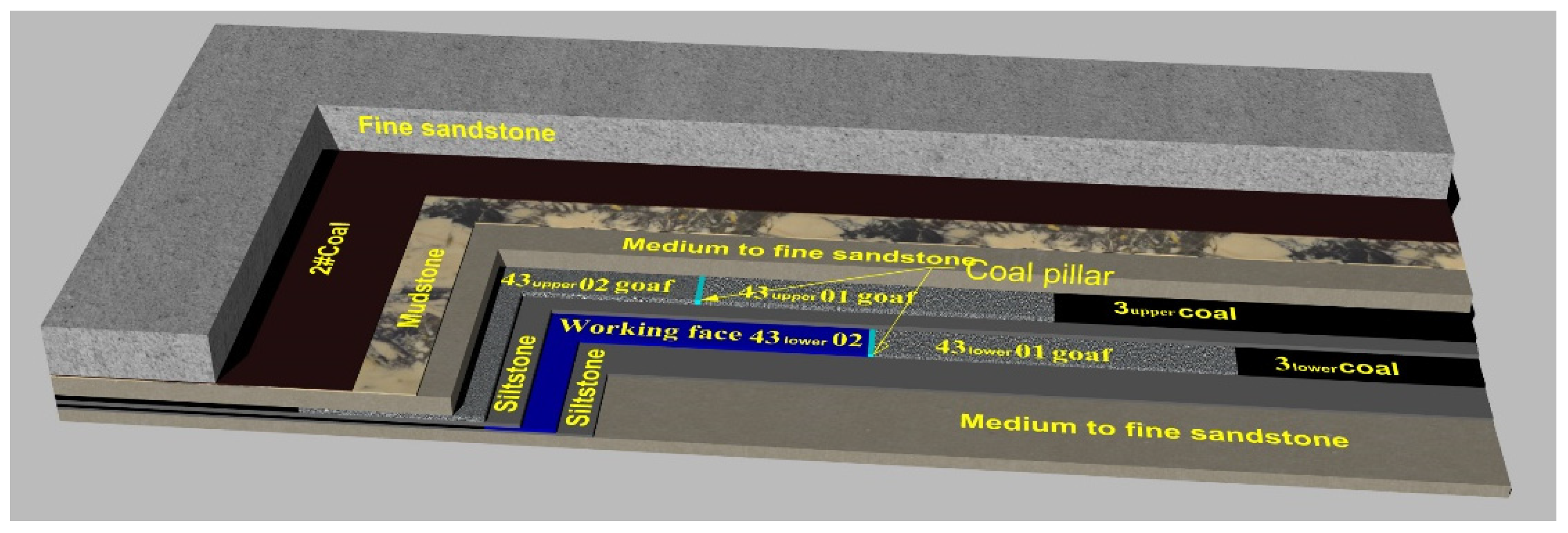
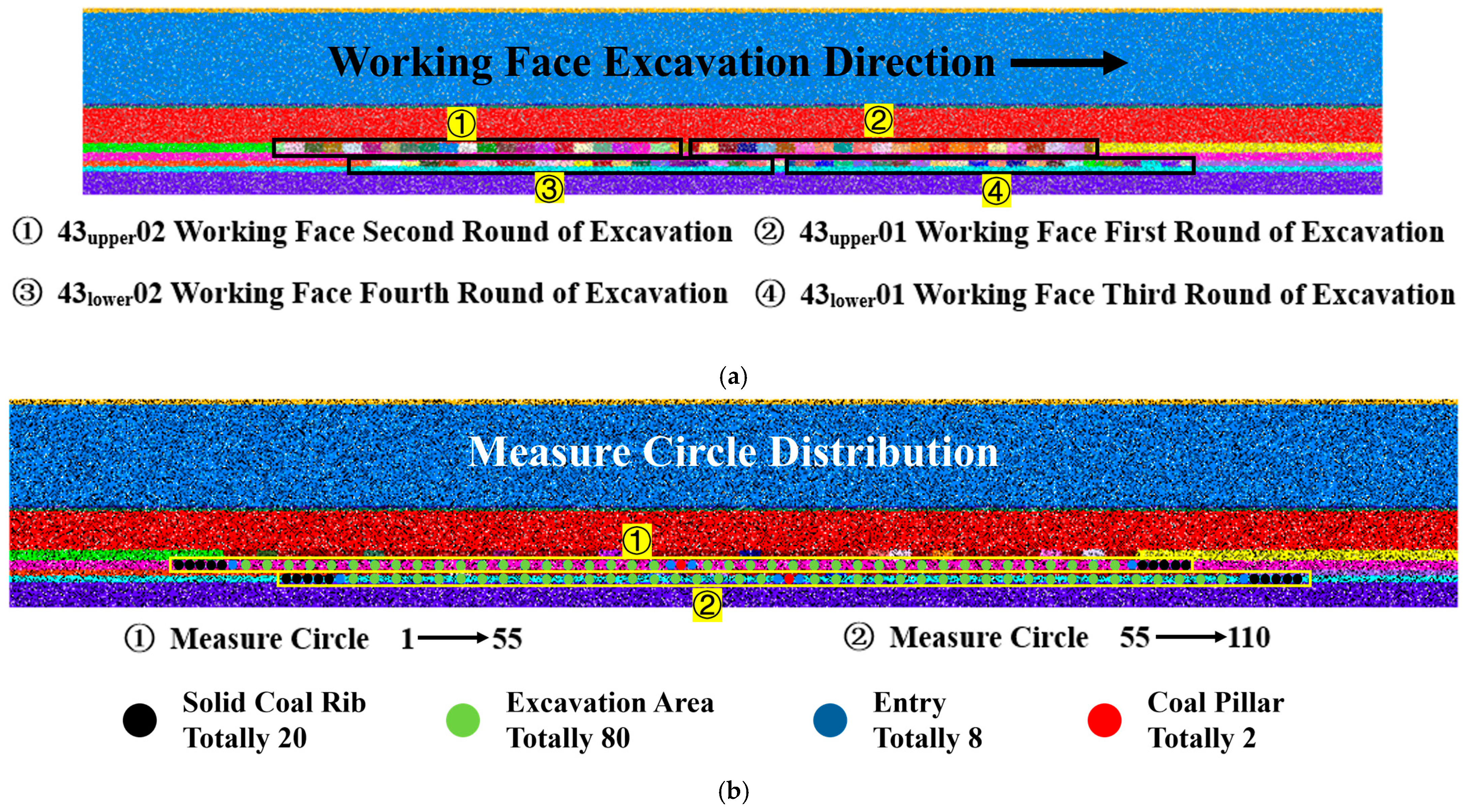






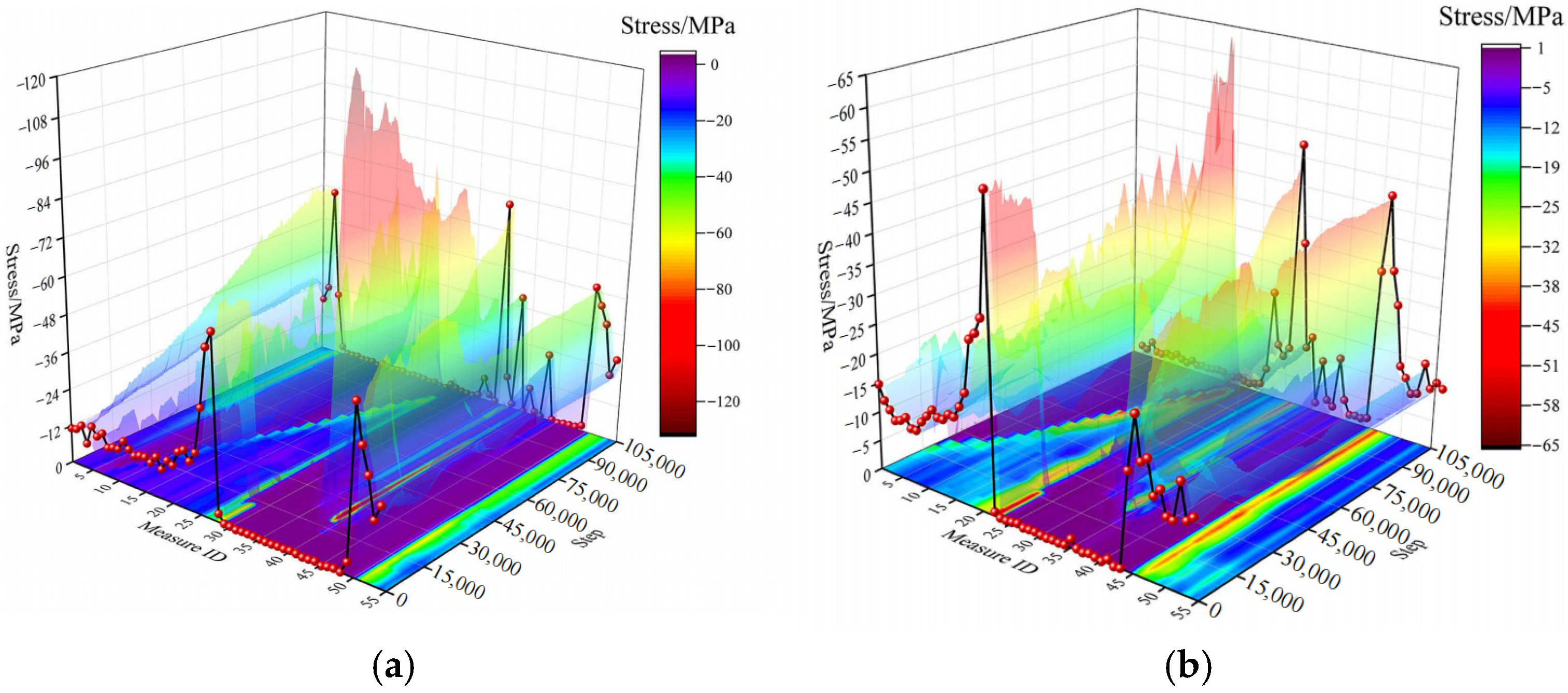
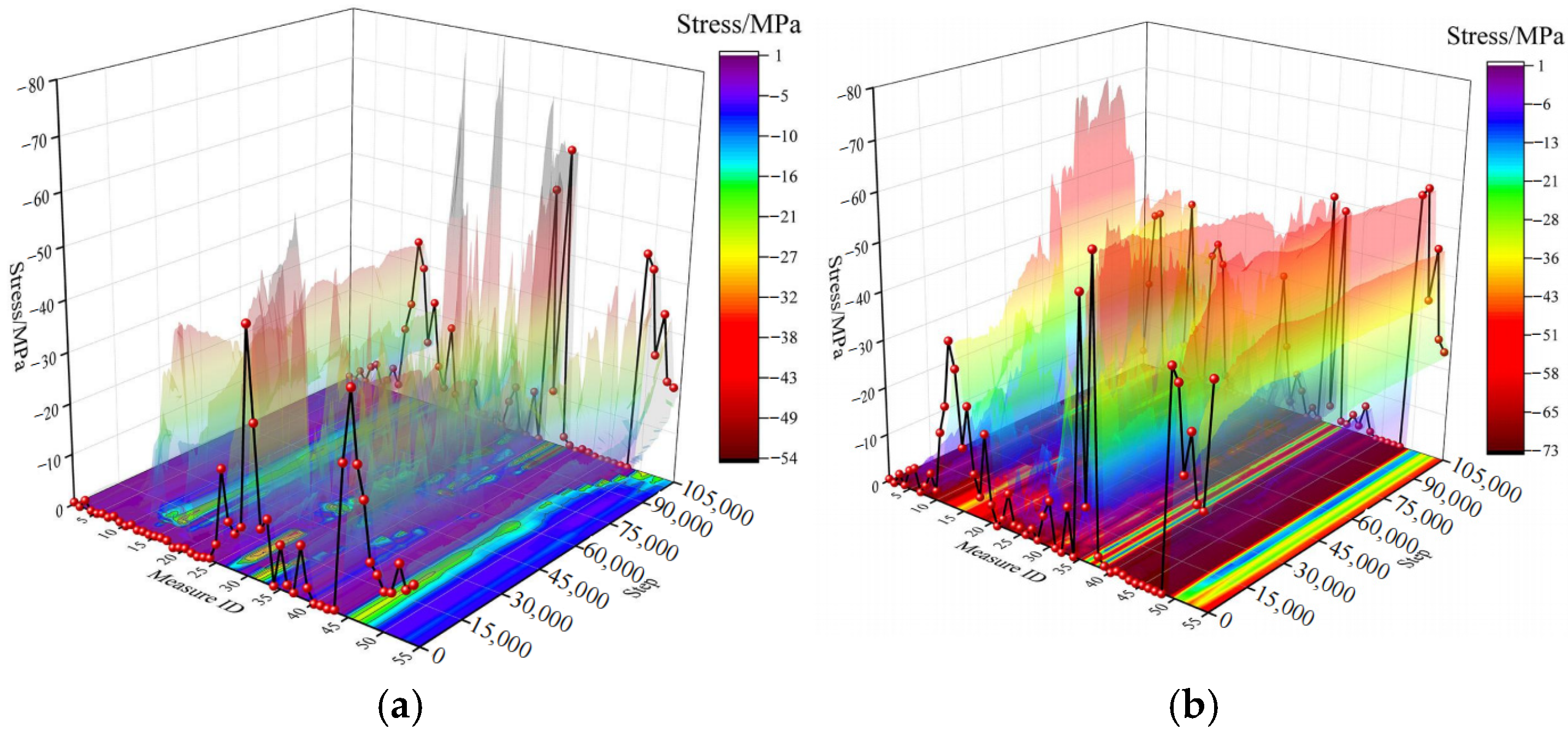
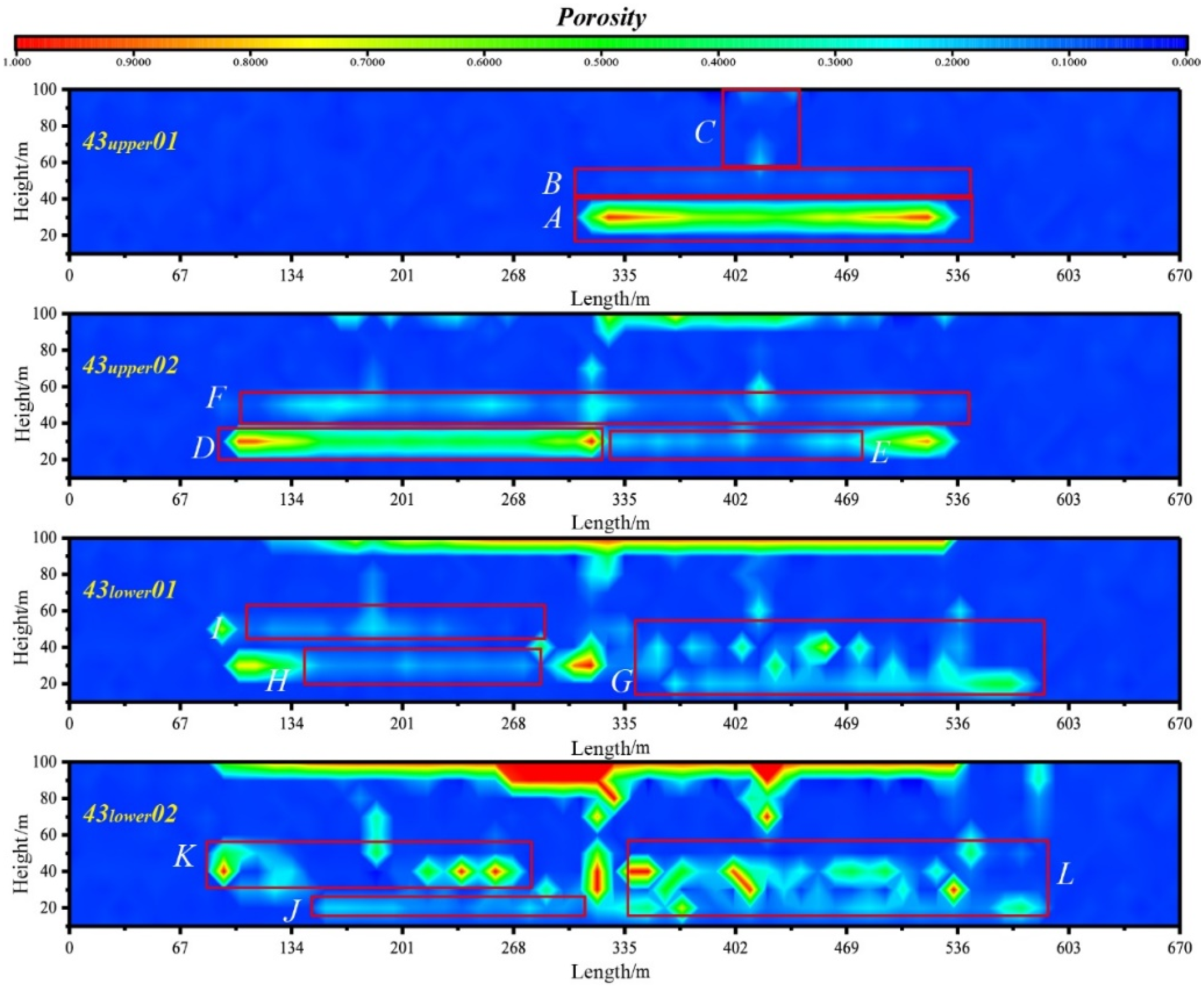

| Layer | Thickness (m) | Bulk Density (kN·m−3) | Compressive Strength (MPa) | Tensile Strength (MPa) | Cohesion (MPa) | Internal Friction Angle (°) | Elastic Modulus (GPa) | |
|---|---|---|---|---|---|---|---|---|
| Serial Number | Rock Type | |||||||
| 1 | Fine sandstone | 47.40 | 23.7 | 37.89 | 3.98 | 4.84 | 24 | 12.26 |
| 2 | 2# coal seam | 0.90 | 1.5 | 26.74 | 1.21 | 2.42 | 38 | 10.72 |
| 3 | Alumina mudstone | 1.41 | 25.32 | 28.44 | 2.74 | 5.74 | 19 | 15 |
| 4 | Medium to fine sandstone | 17.97 | 25.43 | 90.25 | 8.61 | 13.84 | 27 | 36.63 |
| 5 | 3upper coal seam | 5.00 | 1.5 | 29.5 | 2.98 | 2.45 | 22.1 | 13.5 |
| 6 | Siltstone | 4.20 | 25.33 | 72.24 | 7.17 | 11.64 | 19 | 21.29 |
| 7 | 3Lower coal seam | 3.00 | 1.5 | 29.5 | 2.98 | 2.45 | 22.1 | 13.5 |
| 8 | Siltstone | 2.78 | 25.52 | 70.88 | 4.14 | 7.62 | 21 | 20.61 |
| 9 | Medium to fine sandstone | 12.00 | 23.92 | 60.06 | 3.93 | 8.48 | 34 | 20.79 |
| Principal Stress | Stress (MPa) | Azimuth Angle (°) | Dip Angle (°) |
|---|---|---|---|
| σ1 | 22.84 | 90.30 | −19.02 |
| σ2 | 10.85 | 12.51 | −63.10 |
| σ3 | 10.62 | 186.84 | −18.29 |
| σv | 15.09 |
| Layer | Micromechanical Parameters | |||||
|---|---|---|---|---|---|---|
| Serial Number | Rock Type | (GPa) | kn/ks | c (MPa) | (MPa) | |
| 1 | Fine sandstone | 3.05 | 1.1 | 31 | 15.5 | 0.5 |
| 2 | 2# coal seam | 3.50 | 1.40 | 23.4 | 11.7 | 0.5 |
| 3 | Alumina mudstone | 3.88 | 1.40 | 22 | 11 | 0.5 |
| 4 | Medium to fine sandstone | 8.62 | 1.33 | 43 | 21.4 | 0.5 |
| 5 | 3upper coal seam | 3.50 | 1.40 | 23.4 | 11.7 | 0.5 |
| 6 | Siltstone | 5.3 | 1.2 | 57.8 | 28.9 | 0.5 |
| 7 | 3lower coal seam | 3.50 | 1.40 | 23.4 | 11.7 | 0.5 |
| 8 | Siltstone | 5.1 | 1.40 | 56.8 | 27.8 | 0.5 |
| 9 | Medium to fine sandstone | 5.15 | 1.40 | 48 | 24 | 0.5 |
Disclaimer/Publisher’s Note: The statements, opinions and data contained in all publications are solely those of the individual author(s) and contributor(s) and not of MDPI and/or the editor(s). MDPI and/or the editor(s) disclaim responsibility for any injury to people or property resulting from any ideas, methods, instructions or products referred to in the content. |
© 2025 by the authors. Licensee MDPI, Basel, Switzerland. This article is an open access article distributed under the terms and conditions of the Creative Commons Attribution (CC BY) license (https://creativecommons.org/licenses/by/4.0/).
Share and Cite
Xu, J.; Tian, B.; Li, G.; Sun, C.; Rong, H. Numerical Investigation of Disturbance Characteristics of Surrounding Rock in Ultra-Close Coal Seams Mining Based on Particle Flow. Appl. Sci. 2025, 15, 3063. https://doi.org/10.3390/app15063063
Xu J, Tian B, Li G, Sun C, Rong H. Numerical Investigation of Disturbance Characteristics of Surrounding Rock in Ultra-Close Coal Seams Mining Based on Particle Flow. Applied Sciences. 2025; 15(6):3063. https://doi.org/10.3390/app15063063
Chicago/Turabian StyleXu, Jiahui, Bowen Tian, Guichen Li, Changlun Sun, and Haoyu Rong. 2025. "Numerical Investigation of Disturbance Characteristics of Surrounding Rock in Ultra-Close Coal Seams Mining Based on Particle Flow" Applied Sciences 15, no. 6: 3063. https://doi.org/10.3390/app15063063
APA StyleXu, J., Tian, B., Li, G., Sun, C., & Rong, H. (2025). Numerical Investigation of Disturbance Characteristics of Surrounding Rock in Ultra-Close Coal Seams Mining Based on Particle Flow. Applied Sciences, 15(6), 3063. https://doi.org/10.3390/app15063063







